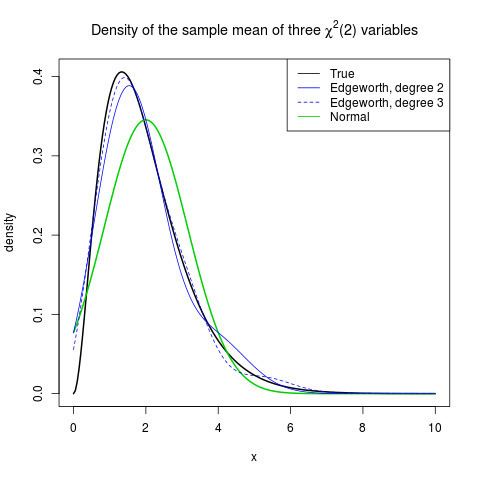 | ||
The Gram–Charlier A series (named in honor of Jørgen Pedersen Gram and Carl Charlier), and the Edgeworth series (named in honor of Francis Ysidro Edgeworth) are series that approximate a probability distribution in terms of its cumulants. The series are the same; but, the arrangement of terms (and thus the accuracy of truncating the series) differ.
Contents
Gram–Charlier A series
The key idea of these expansions is to write the characteristic function of the distribution whose probability density function F is to be approximated in terms of the characteristic function of a distribution with known and suitable properties, and to recover F through the inverse Fourier transform.
We examine a continuous random variable. Let
which gives the following formal identity:
By the properties of the Fourier transform,
If Ψ is chosen as the normal density with mean and variance as given by F, that is, mean
since
with
Note that this expression is not guaranteed to be positive, and is therefore not a valid probability distribution. The Gram–Charlier A series diverges in many cases of interest—it converges only if
The Edgeworth series
Edgeworth developed a similar expansion as an improvement to the central limit theorem. The advantage of the Edgeworth series is that the error is controlled, so that it is a true asymptotic expansion.
Let {Zi} be a sequence of independent and identically distributed random variables with mean μ and variance σ2, and let Xn be their standardized sums:
Let Fn denote the cumulative distribution functions of the variables Xn. Then by the central limit theorem,
for every x, as long as the mean and variance are finite.
Now assume that the random variables Xi have mean μ, variance σ2, and higher cumulants κr=σrλr. If we expand in terms of the standard normal distribution, that is, if we set
then the cumulant differences in the formal expression of the characteristic function fn(t) of Fn are
The Edgeworth series is developed similarly to the Gram–Charlier A series, only that now terms are collected according to powers of n. Thus, we have
where Pj(x) is a polynomial of degree 3j. Again, after inverse Fourier transform, the density function Fn follows as
The first five terms of the expansion are
Here, Φ(j)(x) is the j-th derivative of Φ(·) at point x. Remembering that the derivatives of the density of the normal distribution are related to the normal density by ϕ(n)(x)=(-1)nHn(x)ϕ(x), (where Hn is the Hermite polynomial of order n), this explains the alternative representations in terms of the density function. Blinnikov and Moessner (1998) have given a simple algorithm to calculate higher-order terms of the expansion.
Note that in case of a lattice distributions (which have discrete values), the Edgeworth expansion must be adjusted to account for the discontinuous jumps between lattice points.
Illustration: density of the sample mean of three χ 2 {\displaystyle \chi ^{2}}
Take
We can use several distributions for
Disadvantages of the Edgeworth expansion
Edgeworth expansions can suffer from a few issues:
